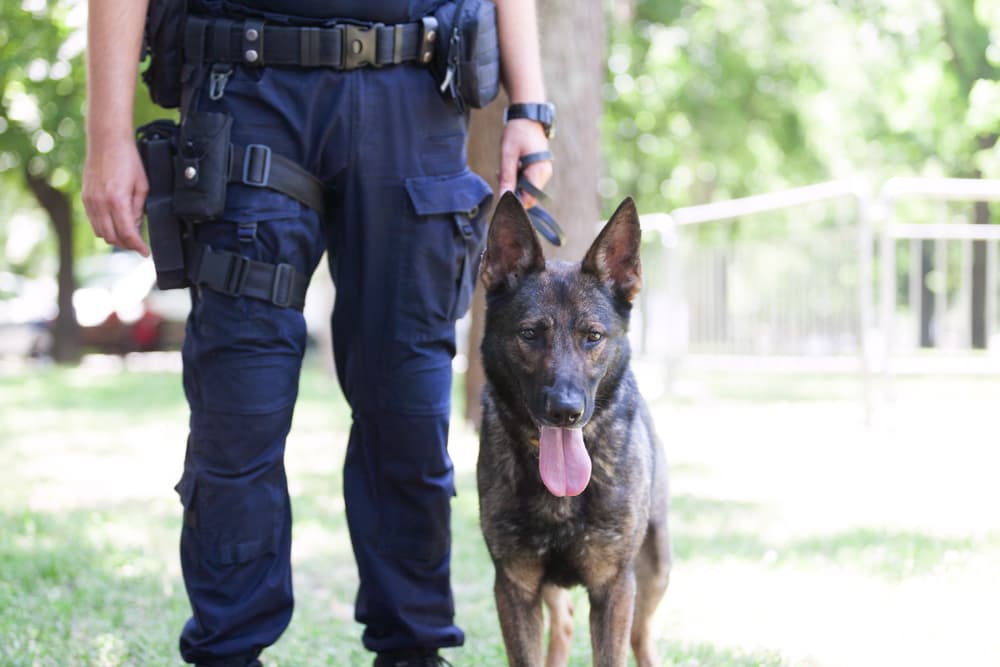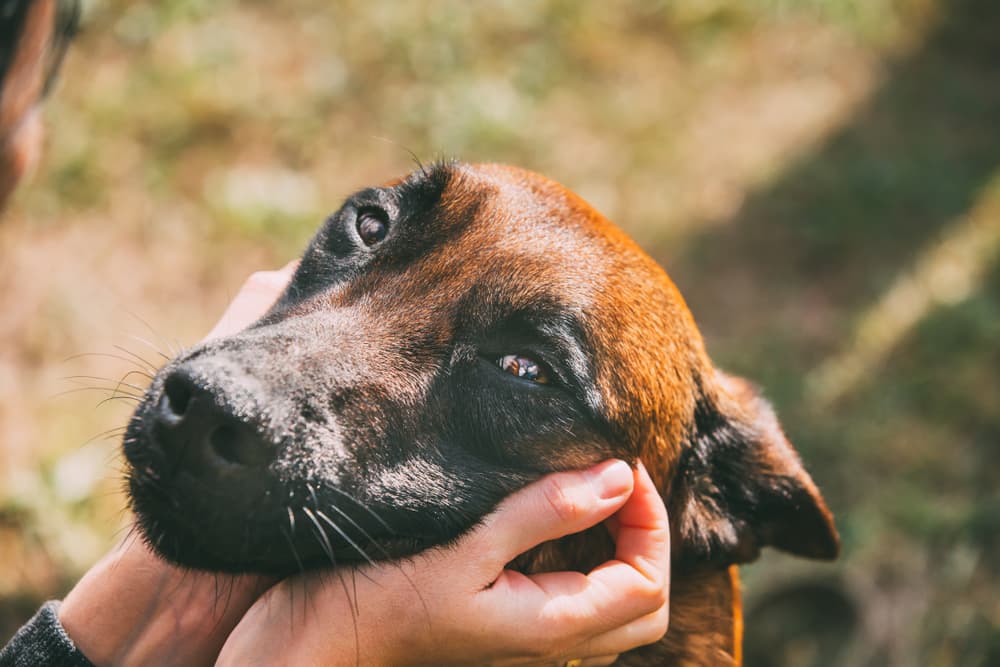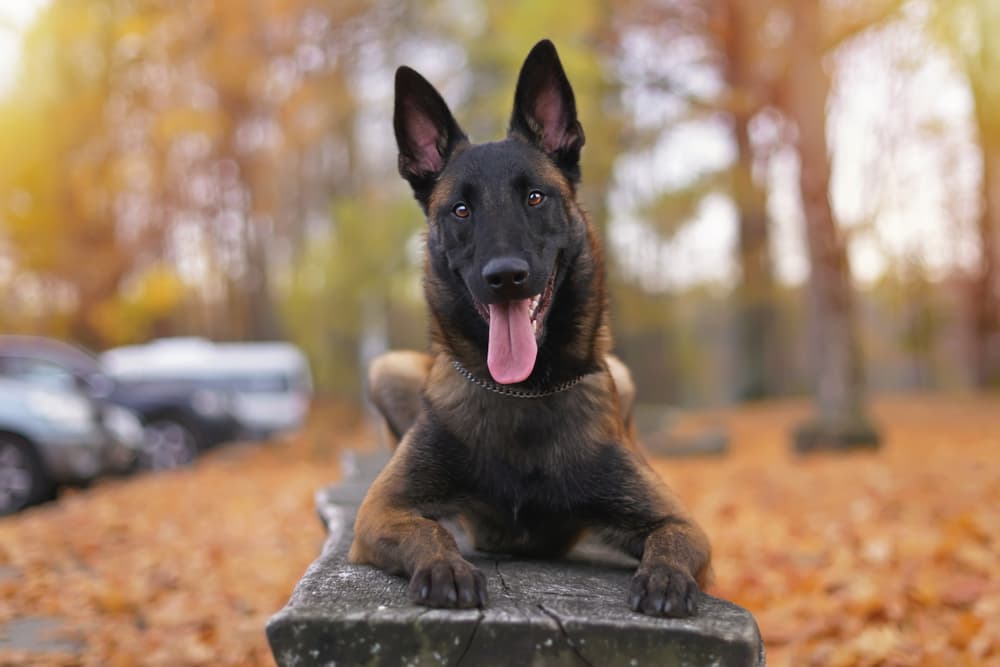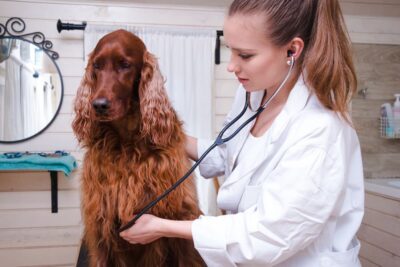Belgian Malinois

Breed Details
- Average Height: 22 to 26 inches at the shoulder
- Average Weight: 40 to 80 pounds
- Dog Breed Group: Working
- Average Lifespan: 10-14 years
-
Key Personality Traits:
Determined
Intelligent
Coachable
Hard Working
Protective
Breed Characteristics
Adaptability
Affectionate
Apartment Friendly
Barking Tendencies
Cat Friendly
Child Friendly
Dog Friendly
Excercise Needs
Grooming
Health Issues
Intelligence
Energy Level
Shedding Level
Social Needs
Stranger Friendly
Territorial
Trainability
Watchdog Instincts
Intelligent and easily trained, the Belgian Malinois exudes confidence and is an exceptional watch and guard dog. Active and energetic, he’s terrific at search and rescue, agility, and pretty much anything else you can teach him.
Although his fawn-colored coat and black mask mean he’s often mistaken for a small German Shepherd, the Belgian Malinois (pronounced mal-in-wah) is a distinct breed. His native country, Belgium, is home to four herding breeds that vary by color and coat type. Named for the town of Malines where he originated, the Malinois is the short-haired variety. He is a medium-size dog with a protective personality and, among other things, has proven adept at police work.
The Malinois has high energy levels and needs much more activity than a simple walk around the block. Choose this breed only if you are a high-energy person who enjoys active daily exercises such as running, bicycling, and hiking. He’s well suited to just about any dog sport or activity you can teach, including agility, flyball, herding, obedience, rally, search and rescue, and tracking.
The ideal Malinois has parents with good temperaments and has been socialized from an early age to be accepting of people when introduced. Those elements — combined with companion dog training — make for a discriminating dog that can make appropriate decisions when it comes to protection.
When the Malinois is raised with children, he can be very accepting. But don’t forget that he is a herding breed and may have the tendency to chase or nip at children. This should never be permitted! He is best suited to a family with older children who understand how to treat him with respect.
The Malinois may or may not get along with cats. He has a strong prey drive and may chase cats or other small furry animals. That said, some Malinois do get along well with indoor cats if they have been raised together.
The Malinois can be aggressive with dogs or other animals he doesn’t know. If your home has a yard, it should be securely fenced to prevent the dog from leaving the premises as well as to keep other dogs from coming onto the property.
Brush the Belgian Malinois’ coat weekly to remove dead hair. He does shed and will need more frequent brushing during that time to control the amount of loose hair floating around. Trim his nails as needed, and keep his ears clean and dry to prevent infections. Strong dental hygiene is also important.
This is an indoor/outdoor dog. While the Belgian Malinois should certainly have access to a securely fenced yard, he should be with his family when they are home. He is best suited to an experienced dog owner.
Other Quick Facts
- The Malinois is one of four Belgian herding dogs that are all considered varieties of a single breed in their homeland.
- The Malinois’ fawn to mahogany-colored coat is tipped with black, and he has a black mask and ears.
- Because of his herding heritage, the Malinois tends to move in big circles
The History of the Belgian Malinois

Known as the Chien de Berger (bair-zhay) Belge (belzh) in Europe, the Malinois is often seen riding in a police car. This herding breed from Belgium — he takes his name from the town of Malines — does not have a well-known history before the late 19th century the late 1800s. He may have been helping shepherds care for flocks for centuries, but it wasn’t until 1891, in a burst of national enthusiasm, that Belgian herding dogs were divided into types and given names.
The shorthaired Malinois became quite popular as a herder, and his abilities were later turned to police and military work. Photos at police dog trials in 1903 show Malinois climbing 10-foot ladders and performing other displays of agility. It’s not surprising that many of the dogs were conscripted during World War I.
The American Kennel Club accepted the breed in 1911, calling them Belgian Sheepdogs and not separating them by coat type. There was little interest in the breed, though, and they had disappeared in the United States by 1939. After World War II, more were imported, and in 1959 the AKC decided to separate them into three different breeds (the fourth breed, the Laekenois, is still not recognized by the AKC because so few exist in this country). The Malinois was less popular than the Tervuren and the Belgian Sheepdog, so he was relegated to the Miscellaneous Class and was not fully recognized again until 1965.
Today the Malinois is a popular police and military dog and can be a good family companion in the right home. He ranks 76th among the breeds registered by the AKC.
Malinois Temperament and Personality
The Malinois is a serious working dog, but that doesn’t mean he isn’t lively and full of fun. Paired with an active family who will make the most of his intelligence and athleticism, he is a happy and affectionate companion who’s known for his sense of humor. He will play with the kids as well as protect them, but as a herding dog with a strong prey drive he may instinctively chase children who are running. Do not allow this! Work with your trainer to teach him strong “Come,” “Down-Stay,” or “Leave It” cues that you can use to stop the behavior. Always supervise play when children are around. He can get along well with cats and other dogs if he is raised with them, but tends to be on the bossy side. Some Malinois are not cat-safe because of their high prey drive.
The Malinois is a great companion for a runner, jogger, or bicyclist. You will probably run out of steam before he does. While a Malinois may easily run for five miles or more, make sure to have your dog examined by your veterinarian before embarking on any exercise program. If your dog is free from any physical or medical conditions that could limit exercise, take him on strenuous hikes or let him run alongside your bicycle. A fenced yard is also essential for helping him get the exercise he needs in a safely confined area. He’ll enjoy fetch games and will chase a ball or flying disc for as long as you can throw it. Agility, flyball, obedience, rally, and tracking are just a few of the dog sports in which he excels. The Malinois loves games and is often described as having a high play drive.
If you work outside the home, schedule daily exercise both to wear him out and give him something to look forward to. If he gets bored, he can do a lot of damage.
It’s important to the Malinois to be a part of the family, and he loves having their attention. He’s wary of strangers and makes an excellent watchdog, but he needs lots of socialization to make sure he doesn’t become overly suspicious. The more people he meets, the better his judgment becomes. A Malinois who is well socialized is a confident dog. When he meets people outside the family, his temperament can range from outgoing to reserved, but he should never be shy or aggressive. Say no thanks if a puppy’s parents aren’t approachable or if a puppy seems either fearful or aggressive.
Train this sensitive and highly intelligent dog with a light touch. He learns quickly and responds to mood and tone of voice; harshness or rough treatment is counterproductive.
What You Need to Know About Malinois Health
All purebred dogs have the potential to develop genetic health problems, just as all people have the potential to inherit a particular disease. Belgian Malinois are no different. However, while they are predisposed to certain health problems, the breed general has fewer health concerns than other dogs. Here are a few of the common health problems seen in Belgian Malinois:
Hip and elbow dysplasia. Dysplasia, or an abnormal formation of the joint, is a common feature of many large dog breeds like the Belgian Malinois. This condition, which can cause significant discomfort and immobility, can be caused by age or simply by predisposition. Treatments for it are largely to reduce pain and increase mobility, including weight loss, physical therapy, supplements, or medication.
Progressive retinal atrophy. This condition is a gradual degeneration of your dog’s eye cells, leading to full or partial blindness as it progresses. It can develop from onset to complete loss of sight in as little as 1-2 years, depending on multiple factors. There are currently no treatments or cures for the condition, but unlike humans, dogs rely more heavily on their other senses like smell and are more likely to lead a successful life without full vision. Always practice good eye grooming on your dog to avoid any other complications.
The American Belgian Malinois Club, which is the American Kennel Club parent organization for the breed in the United States, participates in the Canine Health Information Center Program. For a Belgian Malinois to achieve CHIC certification, he must have OFA or PennHIP certification for hips, an OFA clearance for elbows and an eye clearance from the Canine Eye Registry Foundation. Breeders must agree to have all test results — positive or negative — published in the CHIC database. You can check CHIC’s website to see if a breeder’s dogs have these certifications.
Do not purchase a puppy from a breeder who cannot provide you with written documentation that the parents were cleared of health problems that affect the breed.
The Basics of Malinois Grooming

The Malinois has a short, straight coat that sheds heavily. The coat is heavier around the neck, on the tail, and near the back of the thighs. Brush it at least weekly to remove dead hair and distribute skin oils. Brush a little more often to help keep loose hair from landing on your floor, furniture, and clothing. Bathe him only as needed.
Other basic Malinois care includes trimming his nails as needed, usually every few weeks. Brush the teeth frequently for high overall health and fresh breath.
Choosing a Malinois Breeder
Locating a quality breeder is the key to finding the right puppy. A good breeder will match you with the right puppy, and will have completed all the health certifications necessary to screen out major problems.
Good breeders will welcome your questions about temperament, health clearances, and what the dogs are like to live with. They will come right back at you with questions of their own about what you’re looking for in a dog and what kind of life you can provide. A good breeder can tell you about the history of the breed and discuss what health problems affect the breed and the steps she takes take to avoid those problems. A breeder should want to be a resource for you throughout your dog’s life.
Look for more information about the Malinois and start your search for a good breeder at the website of the American Belgian Malinois Club. Choose a breeder who has agreed to abide by the ABMC’s code of ethics, which prohibits the sale of puppies to pet stores and calls for the breeder to obtain recommended health clearances on dogs before breeding them.
Disreputable breeders and facilities that deal with puppy mills can be hard to distinguish from reliable operations. There’s no 100 percent guaranteed way to make sure you’ll never purchase a sick puppy, but researching the breed (so you know what to expect), checking out the facility (to identify unhealthy conditions or sick animals), and asking the right questions can reduce the chances of heading into a disastrous situation. And don’t forget to ask your veterinarian, who can often refer you to a reputable breeder, breed rescue organization, or other reliable source for healthy puppies.
The cost of a Malinois puppy varies depending on the breeder’s locale, whether the pup is male or female, what titles his parents have, and whether he is considered a show dog. Puppies should be temperament tested, vetted, dewormed, and socialized to give them a healthy, confident start in life.
Before you decide to buy a puppy, consider whether an adult Malinois might be a better fit. Adult dogs may already have some training and will probably be less active, destructive, and demanding. If you are interested in acquiring an older dog through breeders, ask them about purchasing a retired show dog or if they know of an adult dog who needs a new home. If you want to adopt a dog, read the advice below on how to do that.
Adopting a Dog From a Malinois Rescue or Shelter

There are many great options available if you want to adopt a Belgian Malinois from an animal shelter or breed rescue organization. Here is how to get started.
Search Online. Sites like Petfinder.com and Adopt-a-Pet.com are great resources that can help you find a Malinois in your area. You can filter by desired traits and training or be general about your search and see results for all Malinois dogs within a certain location. AnimalShelter.org can help you find animal rescue groups in your area. You can also leverage your social media accounts to search for adoptable Belgian Malinois dogs or use your social network to get your desire for a dog out to the masses.
Talk to Local Experts. Local pet experts such as vets, groomers, and dog walkers may have a tip on an adoptable Belgian Malinois before they become available online. Start reaching out to these experts about your desire for a Malinois. It might just bring you a lead!
Consult a Breed Rescue. Breed clubs have rescue organizations devoted to taking care of homeless dogs. The American Belgian Malinois Club rescue network can help you find a dog that may be a great fit for your family. You can also search online for other Malinois rescues in your area.
Breed rescue groups are generally very upfront about any health conditions the dogs may have and are a valuable resource for advice. They also often offer fostering opportunities, which gives prospective pet parents a chance to see what it’s like to share their homes with a Malinois dog before committing to adoption.
Puppy or adult, schedule a veterinarian visit soon after adoption, even if your dog has had health checks and vaccines in the shelter or from the rescue group. Your veterinarian will be set up a preventive regimen that will help you avoid many health issues and can get your Malinois on the right track.
Belgian Malinois FAQs
Do Belgian Malinois shed?
Belgian Malinois are a moderate shedding breed, so be prepared to find at least some hair around your home year-round.
However, there are two periods out of the year when these dogs shed more than usual. In the spring and fall, Belgian Malinois will undergo a “coat blow,” which is the term used when double coated breeds shed their seasonal coat to adapt to the change in temperature. For example, when springtime rolls around, you can expect more hair falling out as usual as Belgian Malinois shed their winter coat in anticipation of warmer weather.
How much do Belgian Malinois cost?
The average price for a Belgian Malinois puppy without breeding rights or show quality is between $1,000 and $1,500. If you are interested in one with a superior lineage—for example, from a champion show dog—you can expect to spend between $3,500 and $9,000. Or, if you were seeking a Belgian Malinois that has been fully trained for protection or police-specific activities like bomb detection, the breed can cost you anywhere from $45,000 to $100,000.
While you can find Belgian Malinois puppies without papers from a backyard breeder for much cheaper, do not give in to the temptation of a smaller sticker price. Always choose a reputable breeder who can share the genetic health history of your pup. You will likely avoid much costlier health concerns in the long run because of it.
Are Belgian Malinois good with kids?
Belgian Malinois are smart, energetic, and working dogs. They are also “protectors,” making them a great addition to many families. They will loyally protect their pack, while showing loving and gentleness to kids.
Like many dog breeds, Belgian Malinois are prone to nipping when they are puppies, but this trait can easily be eradicated with proper training.
How do you pronounce “Belgian Malinois”?
Belgian Malinois are a herding breed from the Belgian town of Malines. While the first half of their name is simple, the second half is often mispronounced. The correct pronunciation is, “bel-juhn mal-in-wah.”
How long do Belgian Malinois live?
The average lifespan for a Belgian Malinois is 10-14 years. While they are predisposed to some specific health concerns like hip dysplasia, Belgian Malinois generally tend to have fewer health issues than other breeds, especially if purchased from a reputable breeder.
Belgian Malinois Pictures



















